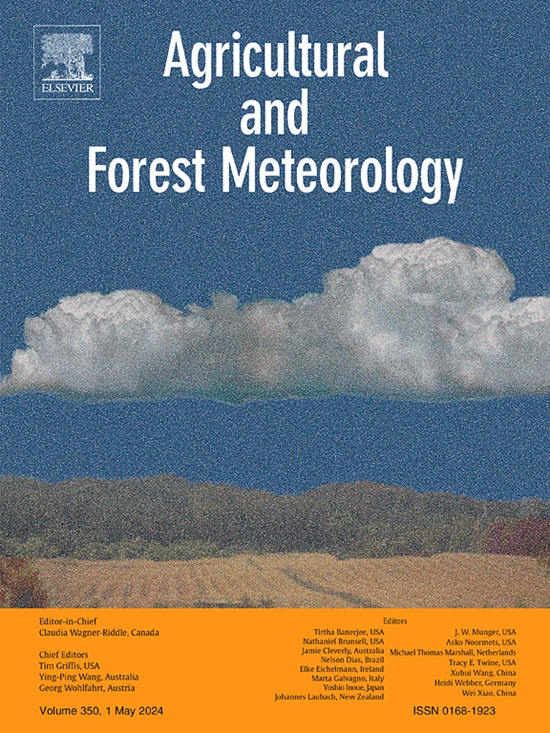Plant life form determines net ecosystem CO2 exchange in a salt marsh under precipitation changes
IF 5.6
1区 农林科学
Q1 AGRONOMY
引用次数: 0
Abstract
Plant life form (annuals and perennials) largely determines community response to the environment. Due to variations in photosynthesis-respiration rates, changes in life form can affect ecosystem respiration (ER) and gross primary productivity (GPP), thus altering net ecosystem CO2 exchange (NEE). Precipitation changes can alter soil moisture-salinity conditions in salt marshes, thus causing significant changes in life form and CO2 sink functions. However, the directional trend and magnitude of such changes along the precipitation gradient are unclear. To fill this knowledge gap, we conducted a field manipulation experiment in a salt marsh in the Yellow River Delta, China since 2014. After six years of simulated precipitation changes (-60 %, -40 %, +0 %, +40 % and +60 % of ambient precipitation), we implemented field monitoring of plant life form, biomass, NEE, ER, GPP and soil moisture-salinity content for three years (2020–2022). Average NEE values under different treatments ranged from -4.8 ± 0.8 to -2.0 ± 0.1 μmol m-2 s-1. We observed that precipitation changes altered plant life form by regulating soil salinity. Soil salinity increased under the precipitation reduction treatments, and annuals with lower productivity replaced perennials as the dominant species, which reduced NEE by suppressing GPP. Conversely, increased precipitation decreases salinity and favored the growth of perennials with high productivity, thus stimulating NEE. NEE showed an increasing trend along the precipitation gradient in this experiment, and the presence of perennials was the key to maintaining high NEE levels. However, species simplification resulting from ongoing increases in precipitation, coupled with a greater aboveground to belowground biomass ratio indicating greater nutrient consumption to support plant growth, may reduce ecosystem resistance and negatively impact future CO2 uptake. Our results highlight that exploring how precipitation changes affect NEE based on life form can simplify the study of ecosystems. These findings can serve as a scientific reference for ecological management.

在降水变化下,盐沼植物生命形式决定了生态系统净CO2交换
植物的生命形式(一年生植物和多年生植物)在很大程度上决定了群落对环境的反应。由于光合作用-呼吸速率的变化,生命形式的变化会影响生态系统呼吸(ER)和总初级生产力(GPP),从而改变生态系统净二氧化碳交换(NEE)。降水变化可以改变盐沼土壤的水分-盐度条件,从而引起生命形式和二氧化碳汇功能的重大变化。然而,这种变化沿降水梯度的方向趋势和幅度尚不清楚。为了填补这一知识空白,我们从2014年开始在中国黄河三角洲的盐沼进行了现场操作实验。经过6年的模拟降水变化(- 60%、- 40%、+ 0%、+ 40%和+ 60%的环境降水),我们对植物生命形态、生物量、NEE、ER、GPP和土壤水盐含量进行了为期3年(2020-2022年)的现场监测。不同处理的平均NEE值为-4.8±0.8 ~ -2.0±0.1 μmol m-2 s-1。我们观察到降水变化通过调节土壤盐度改变了植物的生命形式。减少降水处理使土壤盐分增加,生产力较低的一年生植物取代多年生植物成为优势种,通过抑制GPP降低了NEE。相反,降水增加降低了盐度,有利于高产多年生植物的生长,从而刺激了东北东东。东北东电沿降水梯度呈增加趋势,多年生植物的存在是维持东北东电高水平的关键。然而,持续增加的降水导致的物种简化,加上更大的地上与地下生物量比,表明支持植物生长的养分消耗更大,可能会降低生态系统的抵抗力,并对未来的二氧化碳吸收产生负面影响。我们的研究结果强调,基于生命形式探索降水变化如何影响NEE可以简化生态系统的研究。研究结果可为生态管理提供科学参考。
本文章由计算机程序翻译,如有差异,请以英文原文为准。
求助全文
约1分钟内获得全文
求助全文
来源期刊
CiteScore
10.30
自引率
9.70%
发文量
415
审稿时长
69 days
期刊介绍:
Agricultural and Forest Meteorology is an international journal for the publication of original articles and reviews on the inter-relationship between meteorology, agriculture, forestry, and natural ecosystems. Emphasis is on basic and applied scientific research relevant to practical problems in the field of plant and soil sciences, ecology and biogeochemistry as affected by weather as well as climate variability and change. Theoretical models should be tested against experimental data. Articles must appeal to an international audience. Special issues devoted to single topics are also published.
Typical topics include canopy micrometeorology (e.g. canopy radiation transfer, turbulence near the ground, evapotranspiration, energy balance, fluxes of trace gases), micrometeorological instrumentation (e.g., sensors for trace gases, flux measurement instruments, radiation measurement techniques), aerobiology (e.g. the dispersion of pollen, spores, insects and pesticides), biometeorology (e.g. the effect of weather and climate on plant distribution, crop yield, water-use efficiency, and plant phenology), forest-fire/weather interactions, and feedbacks from vegetation to weather and the climate system.

 求助内容:
求助内容: 应助结果提醒方式:
应助结果提醒方式:


